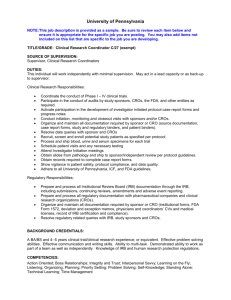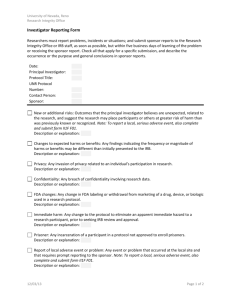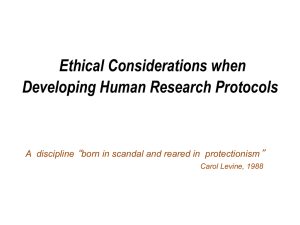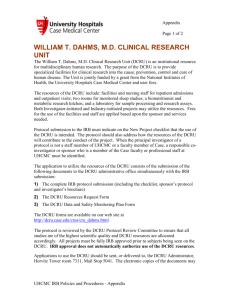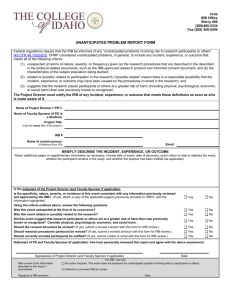Regulatory Binder Guidance
advertisement
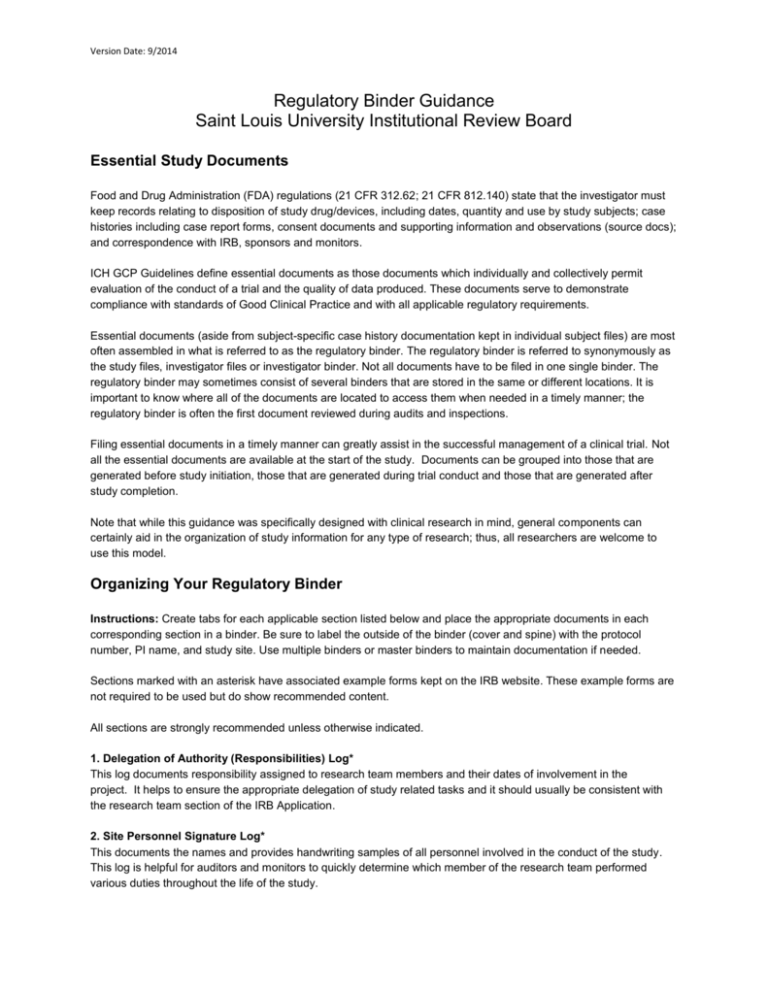
Version Date: 9/2014 Regulatory Binder Guidance Saint Louis University Institutional Review Board Essential Study Documents Food and Drug Administration (FDA) regulations (21 CFR 312.62; 21 CFR 812.140) state that the investigator must keep records relating to disposition of study drug/devices, including dates, quantity and use by study subjects; case histories including case report forms, consent documents and supporting information and observations (source docs); and correspondence with IRB, sponsors and monitors. ICH GCP Guidelines define essential documents as those documents which individually and collectively permit evaluation of the conduct of a trial and the quality of data produced. These documents serve to demonstrate compliance with standards of Good Clinical Practice and with all applicable regulatory requirements. Essential documents (aside from subject-specific case history documentation kept in individual subject files) are most often assembled in what is referred to as the regulatory binder. The regulatory binder is referred to synonymously as the study files, investigator files or investigator binder. Not all documents have to be filed in one single binder. The regulatory binder may sometimes consist of several binders that are stored in the same or different locations. It is important to know where all of the documents are located to access them when needed in a timely manner; the regulatory binder is often the first document reviewed during audits and inspections. Filing essential documents in a timely manner can greatly assist in the successful management of a clinical trial. Not all the essential documents are available at the start of the study. Documents can be grouped into those that are generated before study initiation, those that are generated during trial conduct and those that are generated after study completion. Note that while this guidance was specifically designed with clinical research in mind, general components can certainly aid in the organization of study information for any type of research; thus, all researchers are welcome to use this model. Organizing Your Regulatory Binder Instructions: Create tabs for each applicable section listed below and place the appropriate documents in each corresponding section in a binder. Be sure to label the outside of the binder (cover and spine) with the protocol number, PI name, and study site. Use multiple binders or master binders to maintain documentation if needed. Sections marked with an asterisk have associated example forms kept on the IRB website. These example forms are not required to be used but do show recommended content. All sections are strongly recommended unless otherwise indicated. 1. Delegation of Authority (Responsibilities) Log* This log documents responsibility assigned to research team members and their dates of involvement in the project. It helps to ensure the appropriate delegation of study related tasks and it should usually be consistent with the research team section of the IRB Application. 2. Site Personnel Signature Log* This documents the names and provides handwriting samples of all personnel involved in the conduct of the study. This log is helpful for auditors and monitors to quickly determine which member of the research team performed various duties throughout the life of the study. Version Date: 9/2014 3. Study Personnel Education Required institutional training documentation can be kept in this tab. All personnel involved in research with human subjects are required to complete the following: CITI Course in the Protection of Human Research Subjects (or comparable training that is approved by SLU IRB) HIPAA Training CITI Conflict of Interest Training An optional but recommended course: CITI Good Clinical Practice (GCP). When adding personnel to the study, personnel must complete all of the above and their addition to the protocol must be IRB approved prior to participating in the study. 4. Training Log* This is a record of protocol specific training, e.g. protocol training or other study-specific training of staff. 5. CVs/Conflicts of Interest This section should include the Curriculum Vitae (signed & dated) for all investigators and site staff professional licensure (including DEA if applicable). Any Conflict Of Interest disclosures should also be kept in this section. Please see the Conflict of Interest Office website for details. Note: Anytime information is kept in a master binder, place a note to file (in the section of the Binder) referencing the location of the separate binder and/or make sure all supplemental binders are provided to auditors/monitors to avoid unnecessary findings. 6. Eligibility Criteria Checklist* This section should include a checklist for each subject screened that shows that each inclusion criterion to be in the study is met and the supporting documentation (or reference the location of source documentation). 7. Screening/Enrollment Log* This section should include a log of subjects who were screened (and reason for screen failure) and enrolled. Some studies allow for re-screening of subjects. 8. Subject Visit Tracking Log* This log tracks all enrolled subjects' visits, reason for early termination and keeps visits scheduled as per protocol. 9. Subject Identification Code List* This is a confidential list of the names of all the subjects that provides a link between their identity and their study code to allow the Investigator to reveal the identity of any subject, if necessary. 10. Consent/Assent/HIPAA Authorization Forms (consent materials) This section should include a log to track versions of consent materials and when they were submitted to and approved by the IRB. All consent materials should be kept with IRB approved and stamped versions stored in reverse chronological order with the current approved versions placed first. Place most currently approved consent materials in a plastic sleeve or develop a similar system that clearly establishes the current versions for use. There should also be a listing of subjects showing the date the current version of the consent is signed. (See above Screening/Enrollment Log) Note: Any changes to the consent materials must be submitted to and approved by the IRB prior to use. Version Date: 9/2014 11. Sponsor Protocol, SLU Application, Grant and/or Scope of Work This section should include the sponsor’s protocol, SLU application, grant, and/or scope of work and all amendments/modifications stored in reverse chronological order with the current approved version first. Note: Any changes to the protocol must be submitted to and approved by the IRB prior to implementation. 12. IRB Approval(s) /Communication This section should include copies of the original IRB application/submission, IRB approval letters (contingent and final approval), and all correspondence with the IRB (including emails). It includes continuation review submissions, protocol modifications and DSMB reports and close-out (final study) reports. 13. Sponsor Approval(s) /Communication This section should include copies of correspondence with the study sponor/CRO. 14. Investigational Product Information (as applicable) Investigator's Brochure (IB) This section must include all versions of the IB (may be maintained separately with note in section explaining location of IB) and receipt forms. Evidence of IRB submission and review of all versions must be maintained. Package Insert For FDA approved agents, file a copy of the package insert. Device Manual For device studies this section should have a device information sheet/manual. 15. Study Termination/Closure If your research study is being closed/terminated or if the PI is leaving and the study will no longer be continued, a Final Report form should be submitted in eIRB and related documentation and correspondence kept in this section. 16. Protocol Deviations/Protocol Violations This section should include correspondence relevant to the issue/events and copies of the documents stored in reverse chronological order with the most current documents first. The section can also include IRB and sponsor requirements/guidelines for reporting. 17. Serious Adverse Events This section should include correspondence, copies and acknowledgements of reports for internal SAEs reported to the IRB and Sponsor and FDA as applicable. The section can also include IRB and sponsor requirements/guidelines for SAE reporting. 18. Advertising/Educational Materials (if applicable) This section should include: any IRB approved advertisements, recruitment flyers, written educational, or other materials provided to study participants, stored in reverse chronological order with the most current documents first. Only IRB approved recruitment materials should be used. 19. Lab Certifications This section should include any information related to lab certifications, normal ranges, etc. 20. Drug/Device Accountability Log This section should include a log of dispensation of study drugs/devices, including dates, quantities, returned product, etc. 21. Other Documents Place other important study documents in this section. This can include: certificates of confidentiality, literature or publications, correspondence from the FDA, NIH, etc., Tenet application, Tenet approval letter, SSM RBR approval Version Date: 9/2014 letter, other compliance approvals, cost analyses done by the CTO, FDA Form 1572, IND app/approval, and other general correspondence. Note: If any work with a non-SLU facility or agency is being done or your study includes any clinical procedures, these may need to be in eRS or a determination of the need of collaboration agreement or other legal type of agreement may be needed. Contact the Clinical Trials Office (CTO). Additional Tools: http://www.nia.nih.gov/research/dgcg/clinical-research-study-investigators-toolbox References: Georgetown University Emory University Children’s Hospital Boston
